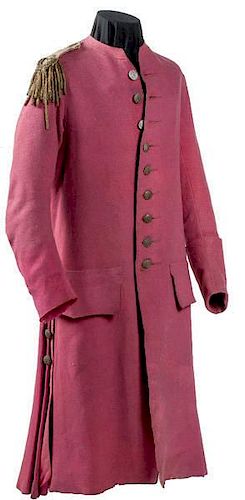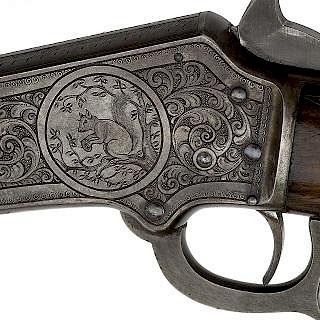Mid-18th Century Man's Civilian Frock Coat with Revolutionary War Epaulet
About Seller
6270 Este Ave.
Cincinnati , OH 45232
United States
With offices in Cincinnati, Cleveland and Denver, Cowan’s holds over 40 auctions each year, with annual sales exceeding $16M. We reach buyers around the globe, and take pride in our reputation for integrity, customer service and great results. A full-service house, Cowan’s Auctions specializes in Am...Read more
Two ways to bid:
- Leave a max absentee bid and the platform will bid on your behalf up to your maximum bid during the live auction.
- Bid live during the auction and your bids will be submitted real-time to the auctioneer.
Bid Increments
| Price | Bid Increment |
|---|---|
| $0 | $25 |
| $500 | $50 |
| $1,000 | $100 |
| $2,000 | $250 |
| $5,000 | $500 |
| $10,000 | $1,000 |
| $20,000 | $2,500 |
| $50,000 | $5,000 |
| $100,000 | $10,000 |
About Auction
Oct 22, 2014 - Oct 23, 2014
Cowan's Auctions dawnie@cowans.com
- Lot Description
Mid-18th Century Man's Civilian Frock Coat with Revolutionary War Epaulet
Single-breasted crimson wool broadcloth frock of a middle class man, 1750 - 1775. Completely hand-sewn construction, with a 1" standing collar, inset skirt pockets with large scalloped flaps, deep pleated skirt side vents and a round cuff on the left sleeve. All cut edges are left raw in the tailoring fashion of the time. Buttons are brass and have pierced geometric pattern tops over a tombac base on a bone backing with wire shanks that pierce the garment and are held by strips of rawhide. All buttons are present. The upper body back, sleeves and pockets are lined in coarse natural linen with the body and skirt lined in middle quality crimson silk; a coarser silk of the same color used to line the skirt vent folds. The single epaulet dates to the 1775 - 1800 period and is of ribbed gold braid with crescent of bullion and sequins, fringed in 3" long galloons, with an applied 8-pointed bullion and sequin star which is backed with linen. The placement of a single epaulet on the right shoulder indicates the rank of a Captain; however, a single star is associated with a Brigadier General. Wear and fading patterns on the coat indicates that the epaulet has long been associated with this garment, although it could have been added at any time before the documented history of the artifact.
The provenance of the coat traces back to the Sanborn-Johonnott family and oral tradition states that it originally belonged to John Sanborn of Salisbury, NH who moved to northern Illinois along the Fox River in 1837. It descended through the family until donated to the Vigo County Historical Society in Indiana in 1967. Exhibit history includes display at its home institution and as part of the Smithsonian sponsored 2005 - 2007 traveling exhibit "Clash of Empires: The British, French and Indian War 1754-1763" at the Senator John Heinz Pittsburgh Regional History Center, the Canadian War Museum and the Smithsonian Institution. It was featured in an article in the Winter 1970 issue of the "Military Collector & Historian: Journal of the Company of Military Historians" and was pictured in the December 2006 edition of Smithsonian Magazine. Provenance and exhibit related documents are included with the coat.
A very scarce early American garment with a rare Continental Army rank insignia that holds the possibility of further research and identification.The coat has been professionally museum conserved with repaired mothing on the rear of the collar and matching fabric replacements made to damaged areas in the lining, some seams have been strengthened, all work skillfully done by hand. The cuff on the right sleeve has been removed. The epaulet has been re-sewn to the coat and has a linen stabilizer sewn over the backing material, the bullion is worn with some loss and several of the galloons have been stretched. Overall, the garment is remarkably well preserved for its age and rarity.Condition
- Shipping Info
-
SHIPPING. At the request of the buyer, Cowan's will authorize the shipment of purchased items. Shipments usually occur within two weeks after payment has been received. Shipment is generally made via UPS Ground service. Unless buyer gives special instructions, the shipping method shall be at the sole discretion of Cowan's Auctions, Inc.. Cowan's is in no way responsible for the acts or omissions of independent handlers, packers or shippers of purchased items or for any loss, damage or delay from the packing or shipping of any property.
-
- Buyer's Premium



 EUR
EUR CAD
CAD AUD
AUD GBP
GBP MXN
MXN HKD
HKD CNY
CNY MYR
MYR SEK
SEK SGD
SGD CHF
CHF THB
THB








